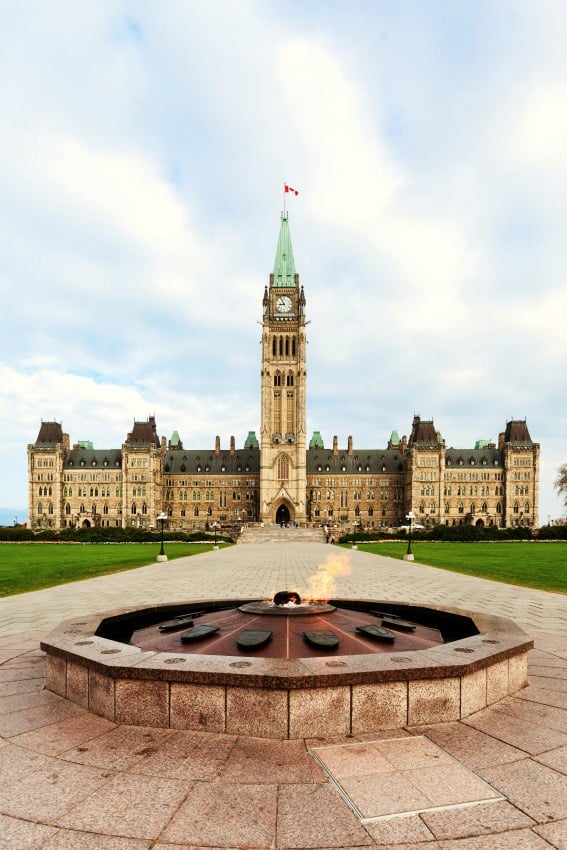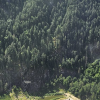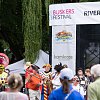If you’re not sure where to start exploring this beautiful country of ours, we’ve put together a list of some of the best Canadian landmarks.
From there, you can plan your ultimate Canadian vacation around them!
Along with amazing historic sites, there are natural wonders, museums and more.
Let us know if you have visited any of the landmarks or if we have left any of your favourites off of the list!
1) Niagara Falls

Niagara Falls is something straight off of a postcard. Once you’re in the city, which is about 130 km from Toronto, it’s free to take in the extraordinary natural wonder. The stroll by the Falls itself is picture perfect perfect during the day and at night, the Falls are illuminated. For a little bit of cash, you can take a cruise through the Falls, a helicopter ride over it or a journey behind the Falls.
2) Peggy’s Cove

Fishing village Peggy's Cove is one of most popular stops in Atlantic Canada. With the rocky shores, lighthouse and village, it has become a photographer's paradise on the Nova Scotia coast, 43 km from Halifax. Even though there are tons of visitors, the tiny fishing village is still the laid back place it always was. Peggy's Cove is truly one of Canada's gems.
3) Parliament Hill

With guided tours daily, you can take in the Centre Block building on Parliament Hill, which is home to the Senate, House of Commons and Library of Parliament. Depending on when you go, you can experience Changing the Guard, a brand new Sound and Light Show and of course, Canada Day. While specific details haven’t been released on this years’ festivities, it’s pretty safe to say the celebration for Canada’s 150th will be the biggest yet.
4) CN Tower

Take a glass elevator to the top floor of Canada’s tallest building, known as the SkyPod- which is also one of the highest observation platforms in the world. A few floors below, you can walk on the glass floor and look to the ground over 1,000 feet below. For an even more thrill-seeking experience, you can take park in the EdgeWalk, the world’s highest hands-free walk. If you want a more chill experience, enjoy a meal at the 360, the Restaurant at the CN Tower, with an unreal revolving view of Toronto.
5) Drumheller

Drumheller is all about dinosaurs. Relive your childhood in the Alberta city where you learn about the science of paleontology at the Royal Tyrrell Museum, come face to face with the world’s largest dinosaur, check out fossils and an animatronic T.Rex. This is a destination for the whole family.
6) Moose Jaw Tunnels

The Tunnels of Moose Jaw, open year round, takes guests on a dramatic journey into Canadian history. Directly below downtown Moose Jaw, tourists can be part of two guided theatrical tours. Relive Al Capone’s bootlegging days in the Chicago Connection tour and experience first-hand the hardships of early Chinese immigrants in the Passage to Fortune tour.
7) Bay of Fundy

The Bay of Fundy is not only a national park, it is also one of the seven wonders of North America and one of the natural wonders of the world. The Bay is found halfway between the equator and the north-pole on the east coast. It’s known for having the highest tides in the world, reaching as high as 16 m (as high as a five-story building), semiprecious minerals and dinosaur fossils and some of the rarest whales on the planet.
8) Granville Island

The Island right off of downtown Vancouver features a huge public market that spans pretty much the whole thing. There you can find local farmers, bakers, butchers, fishermen, florists, jewellers and more, all selling their goods. If you are looking for a spot to sit down and people watch, check out the waterfront courtyard.
9) Old Quebec City

The World Heritage treasure is the only walled city north of Mexico. As one of the original French communities in North America, visiting Old Quebec is like taking a history class. You can learn about both military and religious history. You can visit one of the city's many museums, take a walking tour or a horse-drawn carriage ride to get a true feel for this unique historic district. Fine dining and shopping is never far in Old Québec, with local spots lining rue Saint-Jean and rue Saint-Louis.
10) Confederation Bridge

The Confederation Bridge joins the Atlantic provinces of Prince Edward Island and New Brunswick. The curved, 12.9 km bridge is the longest in the world crossing ice-covered water. After four years of construction, with 5,000 local workers on the project, the Confederation Bridge opened to traffic on May 31st, 1997.
11) Stanley Park

Stanley Park is Vancouver’s largest urban park and was officially designated a national historic site of Canada. Amidst the concrete jungle of the big city, Stanley Park is a green oasis. There is a 400-hectare natural West Coast rainforest, scenic views of water, mountains, sky, and majestic trees along Stanley Park's famous Seawall. Spend time checking out the trails, beaches, local wildlife, local food stops, landmarks and more. Bring the kids and visit Canada’s largest aquarium.
12) Notre-Dame Basilica

Founded back in the 1600s, saying the Montreal church has history would be an understatement. A new building was constructed in the 1800s, although a fire ravaged the chapel in 1978. As part of the reconstruction, the first two levels were built to be identical to the original. If you pay admission to the Notre-Dame Basilica, you get to take a 20-minute guided tour, where you’ll learn about the Parish, the building of the church, key architectural features and the artwork found in the building.
13) Hockey Hall of Fame

The Hockey Hall of Fame in Toronto is home to the Stanley Cup and the best of hockey. Guests can go up against life-size, animated versions of their favourite goalies and shooters, call the play-by-play of some of hockey's greatest goals, view hockey movies in 3D in one of two theatres and take in the largest collection of hockey memorabilia in the world. It’s fun for hockey fans and proud patriots of all ages.
14) Rideau Canal

The historic Rideau Canal waterway winds goes from Ottawa,Ont., through towns, farms and woodlands for 202 km towards Kingston on Lake Ontario. Constructed after the War of 1812, it served as an alternative shipping route between Montréal, Que. and Kingston, Ont. You can get there by road, bicycle, hiking, paddling and leisurely cruises, to take part in self-guided walking trails, where it’s possible to pitch a tent within a historic setting. In the winter, you can skate the frozen canal through Ottawa.
15) Capilano Suspension Bridge Park

Capilano is actually a First Nations name belonging to the Squamish Nation, originally spelled Kia’palano, meaning “beautiful river”. The first suspension bridge in the area was built in 1888 and has since changed owners and improved many times over. Most recently, Vancouver local Nancy Stibbard purchased Capilano Suspension Bridge Park in 1983 in hopes of growing the park’s grasp on tourism. Now, visitors can explore, eat and shop local, all at the park- bringing people from all over the country and the world.
What is your favourite Canadian landmark to visit? Let us know in the comments below!
















